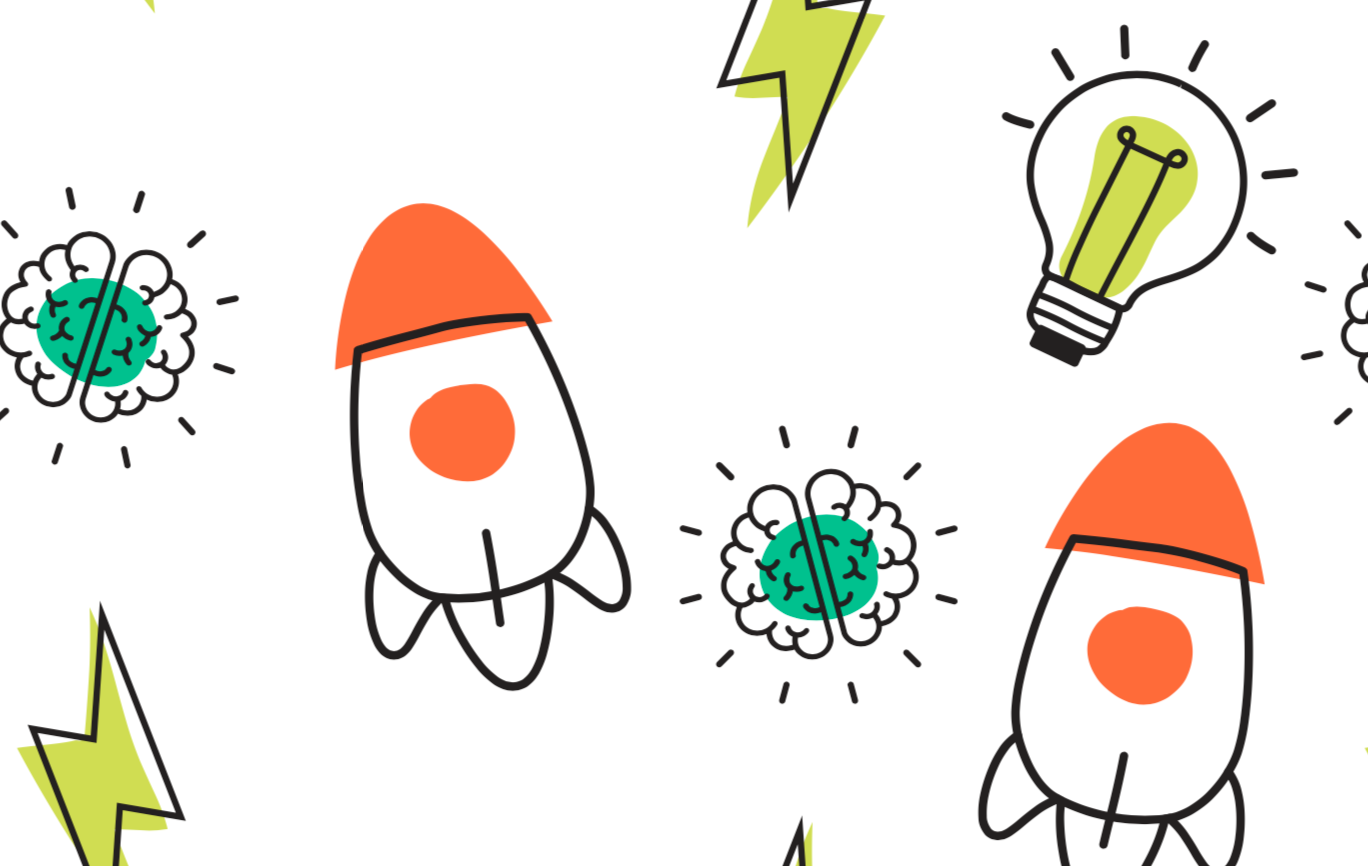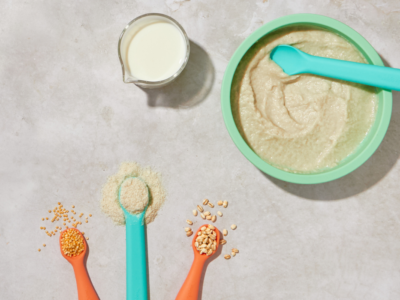Iron: An essential mineral for your baby’s growth and development
Hey mamas! Today we’re going to talk about all the ways your baby needs and uses iron (Spoiler alert! It’s a power nutrient). Things are gonna get a little science-y around here as we take a deep dive into the importance of iron with Anita Tee. Anita is a published scientist and clinical nutritionist who is an expert in child nutrition.
We worked with Anita to bring you a well-researched article about your baby’s brain development full of good information and important takeaways! We’re certainly going to have a lot of fun along the way. Ready? Ready. Good.
How Iron Works
Ok first off, your baby is born with hella iron(1). Enough to get them through their first four months of life, at least. But, a developing child (and their brain!) has a need to continue their iron intake loooong before their intake runs out, as the mineral is incredibly important to their growth and brain function(2). To put it simply: iron is involved in all energy production within the nerve cells. Energy within the nerves allows them to transmit signals. Without iron, the brain just wouldn’t function as it needs to(11,12).
The way iron helps is by:
- Developing the protective layer of fat that surrounds the nerves within brain tissue.
- Playing a role in the chemical messenger (neurotransmitter) functions.
- Being responsible for the proper development of learning ability, motor coordination, and language.
In fact, Anita confided in us that, “One of the most serious and widespread micronutrient deficiencies worldwide is iron deficiency.” She went on to say that babies and toddlers are particularly vulnerable to deficiency. Apparently iron is suuuper important to their growth(3).
Why is Iron important?
Well, Anita told us that Iron is basically what allows red blood cells to be made correctly. She said, “When your iron deficiency is severe enough to be labeled as anemia, the oxygen-carrying capacity of red blood cells is reduced. When there’s too few iron molecules, it also means fewer oxygen molecules can attach to the red blood cells, and so less is delivered to the body, which results in their sub-optimal performance(5).”
This sounds serious to us – basically, what’s going on is that when your baby doesn’t have enough iron, their blood doesn’t work properly. And when their blood doesn’t work properly, the main organ that suffers is. . .you guessed it. . .the brain.
Do We Really Have To Worry
When we asked Anita if we have to be concerned, her answer was apparently yes! In infants and children, iron deficiency can have serious consequences. “One of the major worries,” she said, “is the impact low iron levels have on neurodevelopment” (brain stuff, basically). “From birth to the age of three years old,” she continued, “The brain triples in size.”
A lot of mamas know this already, as it pretty much explains why the terrible twos are so terrible: there’s a lot of growth happening! And for that growth to happen, iron is critical. Essentially, iron is involved in energy production within our nerve cells. Including sending chemical messages. Our brain is the part of our body that processes those signals. To both send and process our bodies’ messages we need iron(11,12).
But How Does That Affect Me
“Globally, we are looking at a problem that sees 25% of preschool children living with iron deficiency anemia,” Anita said. And then with the same no-nonsense seriousness continued, “Studies in infants with low iron levels proves that it has an effect on their overall cognitive function as well as their behavior and performance. So, yes, it’s important(13).”
Our response was pretty much “!” And when we asked her what we could do, she explained:
(1) BE AWARE.
“Unfortunately, it’s quite hard to tell if your little one is in danger, so watch out for signs that include an unusually pale skin tone, atypical fatigue, slowed growth, or missed developmental milestones. If they don’t want to eat, their breathing rate seems erratic or abnormal, or they have frequent infections, they might be iron deficient.” She went on to say that the American Academy of Pediatrics recommends that all infants, starting from age nine months, be routinely tested for iron deficiency until they are one year old. In those that require further testing and screening, this will usually be done on a case-by-case basis, in conjunction with recommendations from your child’s doctor.
(2) BE MINDFUL OF WHAT THEY ARE EATING AND IN WHAT COMBINATION.
“As you begin to change your baby’s diet to include solid foods around the age of four to six months, be sure to focus on foods that contain iron,” Anita advised.
The Mayo Clinic recommends the following daily supply of iron provided to infants and children:
- 7-12 months 11mg
- 1-3 years 7mg
She suggested that it could be helpful to make your own iron-rich, brain-nourishing meals (though we at Little Spoon know this can be soooo time consuming, especially for a working parent), or choose meals which you know contain high levels of iron(19).
“Enhancing the absorption of iron is an important part of the process!” she confessed. “Iron typically doesn’t exit the intestines well, which is where Vitamin C comes in because it can help the movement of iron from the digestive system into the bloodstream. Adding some sweet, vitamin C-rich fruit treats to meals and snacks, or served as purees alongside iron-rich foods can help.”
Early research into the ability of vitamin C to help iron absorption apparently shows that the vitamin can also prevent other compounds from hindering iron absorption! “Nutrients like phytates (found in beans and legumes), polyphenols (found in leafy green vegetables and some fruit), as well as calcium (found in dairy products), all restrict the body’s ability to absorb and utilize iron,” she said. Which we basically took to mean, with the addition of foods rich in vitamin C lots of digestive-limitations can be overcome (20,21,22). (Pro tip: Try our Tropical Greens and Avocado Greens Bowl Babyblends to get a nice dose of vitamin C.
(3) FURTHER BOOST YOUR BABY’S IRON INTAKE WITH SOLUBLE IRON SUPPLEMENTATION.
To ensure adequate levels, Anita suggests taking an iron supplement, which can begin at four months of age in full term babies and can continue until you’re providing your child with at least two iron-rich foods every day. If you are already providing an iron-containing formula and it forms a large portion of your baby’s food intake every day, congratulations mama! You have things more together than we did(18).
If you and your doc decide to use an iron supplement for your mini, Anita helped us devise the checklist in finding a good one:
- Bioavailability of the iron source: heme iron—the most active form of iron (versus non-heme iron)—is preferred
- Absorption: Vitamin C boosts the absorption of the iron and is best to take in tandem with an iron source
- Containing:
- DHA, which is an omega 3 fatty acid, is essential for brain development and learning
- Vitamins that provide powerful antioxidants that prevent DHA from oxidizing such as Vitamin E
- Vitamin D for their bones and general health and growth
- Clean, natural ingredients with no additives or preservatives! And note Anita’s caution: “Fortified baby cereals can be a good option—but many contain potentially harmful preservatives.”
When you have a preterm little one, things are a little different. Usually additional iron is recommended from two weeks of age and on, but this can be tricky so we recommend talking with your pediatrician.
Now what?
Understanding how iron relates to your baby’s growth and development—and how it forms a crucial part of those developmental milestones—empowers you to take the right course of action for you baby’s overall health and wellbeing.
Before adding supplements to your child’s routine check in with your pediatrician. But in the meantime when introducing solids into your baby’s diet keep their noggin in mind as you’re shopping. You want greens, beans, and Vitamin C to help you meet that Mayo Clinic iron-requirement. Your little one’s growth and development will thank you, as will one of their most essential organs: their brain.
We did the research so you don’t have to. Still, if you want to check our sources, here are our references:
- Mayo Clinic. Iron deficiency in children: Prevention tips for parents. Children’s Health.
- Lanzkowsky, P. Chapter 6 – Iron-Deficiency Anemia. Lanzkowsky’s Manual of Pediatric Hematology and Oncology (Sixth Edition). 2016, Pages 69-83
- Domellof, M., et al. Iron Requirements of Infants and Toddlers. JPGN. 2014;58: 119–129.
- Geneva: Switzerland: World Health Organization; 2001. WHO/UNICEF/UNU. Iron Deficiency Anemia Assessment, Prevention, and Control; p. 114.
- Wood RJ, Ronnenberg A. Iron. In: Shils ME, Shike M, Ross AC, Caballero B, Cousins RJ, editors. Modern Nutrition in Health And Disease. 10th ed. Baltimore: Lippincott Williams & Wilkins; 2005. pp. 248–70.
- McLean E, Cogswell M, Egli I, et al. Worldwide prevalence of anaemia, WHO Vitamin and Mineral Nutrition Information System, 1993–2005. Public Health Nutr 2009;12:444–54.
- Bramhagen A-C, Axelsson I. Iron status of children in southern Sweden: effects of cow’s milk and follow-on formula. Acta Paediatr 1999;88:1333–7.
- Male C, Persson LA, Freeman V, et al. Prevalence of iron deficiency in 12-mo-old infants from 11 European areas and influence of dietary factors on iron status (Euro-Growth Study). Acta Paediatr 2001;90: 492–8.
- Hay G, Sandstad B, Whitelaw A, et al. Iron status in a group of Norwegian children aged 6–24 months. Acta Paediatr 2004; 93:592–8.
- Vendt N, Grunberg H, Leedo S, et al. Prevalence and causes of iron deficiency anemias in infants aged 9 to 12 months in Estonia. Medicina (Kaunas) 2007;43:947–52.
- Beard J. Iron deficiency alters brain development and functioning. J Nutr 2003;133 (5 suppl 1):1468S–72S.
- Carlson ES, Tkac I, Magid R, et al. Iron is essential for neuron development and memory function in mouse hippocampus. J Nutr 2009;139:672–9.
- Lozoff B, Beard J, Connor J, et al. Long-lasting neural and behavioral effects of iron deficiency in infancy. Nutr Rev 2006;64 (5 pt 2):S34–43.
- Collard KJ. Iron homeostasis in the neonate. Pediatrics. 2009;123:1208–16.
- Ziegler EE, Nelson SE, Jeter JM. Iron supplementation of breastfed infants from an early age. Am J Clin Nutr. 2009;89:525–32.
- Ziegler EE, Nelson SE, Jeter JM. Iron supplementation of breastfed infants. Nutr Rev. 2011;69Suppl 1:S71–7.
- Institute of Medicine Food Nutrition Board. Dietary reference intakes: vitamin A, vitamin K, arsenic, boron, chromium, copper, iodine, iron, manganese, molybdenum, nickel, silicon, vanadium and zinc. Washington (DC): National Academies Press; 2001.
- Petry, N.; Olofin, I.; Boy, E.; Donahue Angel, M.; Rohner, F. The Effect of Low Dose Iron and Zinc Intake on Child Micronutrient Status and Development during the First 1000 Days of Life: A Systematic Review and Meta-Analysis. Nutrients 2016, 8, 773.
- Chen, A., et al. Screening for Iron Deficiency. Pediatrics in Review Vol.23 No.5 May 2002.
- Hurrell R, Egli I. Iron bioavailability and dietary reference values. Am J Clin Nutr. 2010 May; 91(5):1461S-1467S.
- Teucher B, Olivares M, Cori H. Enhancers of iron absorption: ascorbic acid and other organic acids. Int J Vitam Nutr Res. 2004 Nov; 74(6):403-19.
- Lynch SR. The effect of calcium on iron absorption. Nutr Res Rev. 2000 Dec; 13(2):141-58.
- Lonnerdal, B. Excess iron intake as a factor in growth, infections, and development of infants and young children. The American Journal of Clinical Nutrition, Volume 106, Issue suppl_6, December 2017, Pages 1681S–1687S.
- Paganini, D.; Uyoga, M.A.; Zimmermann, M.B. Iron Fortification of Foods for Infants and Children in Low-Income Countries: Effects on the Gut Microbiome, Gut Inflammation, and Diarrhea. Nutrients 2016, 8, 494.
— ref



